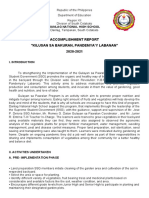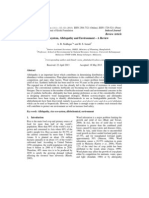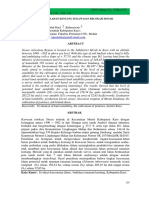Agriculture Is The Backbone of Nepalese Economy
Agriculture Is The Backbone of Nepalese Economy
Uploaded by
Smriti pantCopyright:
Available Formats
Agriculture Is The Backbone of Nepalese Economy
Agriculture Is The Backbone of Nepalese Economy
Uploaded by
Smriti pantOriginal Title
Copyright
Available Formats
Share this document
Did you find this document useful?
Is this content inappropriate?
Copyright:
Available Formats
Agriculture Is The Backbone of Nepalese Economy
Agriculture Is The Backbone of Nepalese Economy
Uploaded by
Smriti pantCopyright:
Available Formats
Agriculture is the backbone of Nepalese economy, means of livelihood for the majority of the
Nepalese population and the source of income and employment. Agriculture contributes about
25.7% of the GDP and 65.6% for the employment (MOALD,2020)
Maize ( Zea mays L) commonly known as corn in the USA and Canada, considered as the third
most important cereal grain worldwide after wheat and rice.(Golob et al.) Maize was considered
as the future cereal for its nutritional value and utilization of its products and by-products (lee,
1999). Due to diverse uses of the corn from human food and animal fed to ethanol production,
there has been significant increase of demand of maize throughout the world (FA0,2016). Maize
per capita consumption in Nepal was 98 g/person/day (Ranum et al., 2014). Along with serving
as human food and animal feed, maize was found to be applied for industrial applications. In
addition to staple food, maize also served as a basic raw material as an ingredient to thousands of
industrial products starch, oil, protein, alcoholic beverages, food sweeteners, pharmaceuticals,
cosmetic, film, textile, gum, package and paper industries etc. (Masood, et al., 2011).
2.1) Weed flora and their effects on maize yield
There are several factors that results in the yield losses in crops due to weeds such as weed
emergence time, weed density, type of weeds, and crops, etc. Weed can result up to 100% yield
loss if left uncontrolled and unchecked. In Australia, around AUD 3.3 billion is estimated for the
overall cost of weeds for the farmers (Llewellyn et al., 2016). Weeds amounted to 2.7 million
tons of grain at a national level in the terms of the yield loss. Over 11 billion USD annually
hampers to agriculture production system due to weeds. (Gharde et al., 2018). As the weed
compete for light, water, nutrients and carbon dioxide that ultimately reduce the crop yield and
interfere with harvesting and increase the cost involved in crop production depending on the type
of weed flora, intensity and duration of crop weed competition (Oekre, 2005). There is no
significant or gain of weeding in maize after the critical period of weed removal as it can result
in up to 83% losses in grain yield (Ehsas et al., 2016). First six weeks DAS of maize is the most
critical period for crop-weed competition which may reduce the yield up to 28-100% (Daas et
al.,2012). Gopinath and Kundu (2008) reported that in order to achieve the higher yields the
weed competition during the early crop growth stages should be low. During this period,
weeding is essentially required. Physical and mechanical means of the weeding are not cost
effective i.e expensive and many times timely operations are not possible due to continuous rains
in monsoon season [Chopra and Angiras 2008)]. Density, competitiveness and emergence
periodicity of the weed population determines the critical period of the crop weed competition.
(Evans et al.,2003) ( Bystro JP et al.,2012)
Porwal (2000) observed that the winter season maize was dominated by broad leaf weeds
like Chenopodium album, C. murale, Melilotus indicia, Anagallis arvensis, Convolvulus
arvensis and Euphorbia hirta, sedges like Cyperus rotundus and grass like Cynodon dactylon.
Malvaiya and Singh (2007) observed the Cyperus rotundus, Cynodon dactylon, Eclipta alba,
Solanum nigrum, Digeria arvensis, Phyllanthus niruri, Echinochloa colonum and Commelina
benghalensis as the predominant weed species that infest the maize fields. However at 90 days
after sowing the weed species found were: Cyperus rotundus (55.08 % and 54.99%), Cynodon
dactylon (36.91% and 37.05%), Echinochloa colonum (3.91% and 4.05%) and Commelina
benghalensis (3.92% and 4.05%).Similarly, Tahir et al. (2009) observed that the major weeds in
the field of spring maize were Cyperus rotundus, Tribulus terrestris, Dactyloctenium aegyptium,
Cynodon dactylon, Fumaria indica, Chenopodium album, Convolvulus arvensis, Rumex dentatus
and Portulaca oleracea.
Sharma et al. (2000) observed that the loss in grain yield up to 42.3% in one year and 32.4%
in the succeeding year due to the uncheck weed growth of the rainfed maize. Pandey et al.,
(2001), found a serious negative impact in the crop production and the losses varying from the
28 to 100% due to kharif season maize weeds. Dangwal et al., (2011) observed that weeds
caused the devastating damaged to the producers i.e farmer which reduce the yield of maize crop
by 30.61%.
2.2) Effect of weed management on maize yield
Joshi (2004) stated that first weeding on 14 days after emergence i.e around 21 days produced
the highest plant stand (32/7.2 m-2),plant height (190 cm), crop biomass (8.1 t ha-1),the number
of ears (38888 ha-1) and grain yield\(4.3 t ha-1). He concluded that the two weeding practices
appeared to be economical in farmer field condition i.e first weeding practice done 25-30 DAS
and second weeding practices done 50-60 DAS. During the first 4 weeks, the crop canopy of the
growth of maize is inadequate to smother the weed growth due to its wider row spacing and slow
growth so the weed competition in crop field is in variably severe in early stage of crop growth
than later stage. If weed is uncontrolled between the period 15-45 days it results in the loss of 15
to 40% grain yield reduction as these periods are the critical for the weed crop competition
(Mishra, 1997). Generally, first 35 days after sowing, field should be made weed free for the
optimum yield in a crop of 100 days duration. Intensity of infestation, time of occurrence and type
of weeds determines the extent of losses caused by the weeds. (Reedy and Reddi, 1997). Both types
of weeds (narrow/grassy and broad) infest the maize field.
2.3) Atrazine
Application: used as pre- emergence or early post emergence
Mode of action: It is mostly absorbed through roots as pre-emergence application in maize and
enters the plant parts rapidly, then accumulates in the apical meristem and in chloroplasts of
susceptible weed species. Photosynthesis and enzyme reaction are inhibited by it. At first, in
mature leaves it causes foliar chlorosis showing margin inwards. It prevents the opening of
stomata in the presence of the light by reducing thickness of cell wall. Plant and root system are
weakened by the inhibition of carbohydrate synthesis resulting in subsequent death of weeds
(Kannur, 2008).
Uses: Selective preemergence herbicide for control of many broadleaf weeds and grasses in
maize, sorghum, sugarcane, pineapple, turf and orchards. However, in non-crop areas and in
minimal or no tillage programmes in maize and sorghum it is also used as non-selective
herbicides (Rao, 2000). It is recommended at the rate of 1- 4 kg actual/ ha and 10-15 kg actual/ha
as seasonal soil sterilant.
2.4 ) 2,4-D ethyl ester
2,4-Dichlorophenoxyacetic acid (2,4-D) was the first synthetic herbicide to be commercially
developed having molecular formula C8H6Cl2O3and has commonly been used as a broadleaf
herbicide for over 60 years. It is a selective and systematic herbicide used as post emergence that
kills dicots without affecting monocots and mimics natural auxin at the molecular level.
Physiological responses of dicots sensitive to auxinic herbicides include abnormal growth,
senescence, and plant death. The identification of auxin receptors, auxin transport carriers,
transcription factors response to auxin, and cross-talk among phytohormones have shed light on
the molecular action mode of 2,4-D as a herbicide
2.5) Effects of herbicidal control on weed density and yield of maize
Shankar et al. (2015) found that the lower density and dry weight of the weeds/m 2 with the
application of atrazine (50%) @1.25 kg/ha or pendimethalin (50%) @ 2.5 lit/ha as compared to
the other chemical weed management weed treatment. Chopra and Angiras (2008) observed that
atrazine @1.5 kg ha-1 (9.8 and 13.2 no. m-2) resulted in significantly lower total weed count as
compared to unwedded check (19.4 and 21.2 no. m-2) during both (2002 and 2003, respectively)
years. Kolge et al (2004) observed that lowest weed population was with application of atrazine
@ 1kg/ha and pre emergence application of atrazine 0.5 kg/ha followed by one hand weeding at
30 DAS. Kannan and Chinnagounder [2014] reported that lower weed density was achieved
under non transgenic maize hybrid BIO 9681 and 30B11 with PE application of atrazine at 0.5
kg ha-1 fb HW at 20 DAS. Reddy et al. (2012) stated that the weed control efficiency recorded at
30 DAS was higher in atrazine + glyphosate (93%) followed by atrazine + paraquat (84%).
Glyphosate was found to be superior to atrazine in terms of cob length, number of grains/cob and
100 grains weight due to better control of weeds. The effectiveness of herbicidal control is 100%
(Mukhopadyay, 1991). A field experiment was conducted during rainy seasons (kharif) of 1998
and 1999 at the research farm at the Vishvavidyalaya, Palampur Shown that all the doses of
atrazine, i.e 1.0, 1.5 and 2.0 kg/ha gave significantly lower dry weight of weeds as compared to
the weedy check. Varshney (1990) also observed Atrazine 2.0 kg/ha most effective for weed
control in maize which reduced the weed biomass by 62-70%. With delay in time of application
of atrazine commencing from pre-emergence, there was decrease in weed control efficiency and
increase in dry matter accumulation in weeds.
You might also like
- 20.App-Effect of Weeds and Their Management in Transplanted Rice - A ReviewNo ratings yet20.App-Effect of Weeds and Their Management in Transplanted Rice - A Review16 pages
- Allelopathic Intercrops and Its Mulch As An Integrated Weed Management Strategy For Rainfed BT - Transgenic Cotton HybridsNo ratings yetAllelopathic Intercrops and Its Mulch As An Integrated Weed Management Strategy For Rainfed BT - Transgenic Cotton Hybrids9 pages
- Management of Brinjal Shoot and Fruit Borer (Leucinodes Orbonalis Guen.) Using Selected Bio-Rational InsecticidesNo ratings yetManagement of Brinjal Shoot and Fruit Borer (Leucinodes Orbonalis Guen.) Using Selected Bio-Rational Insecticides7 pages
- Siddique and Ismail 11 (1) 112-121 (2013) Review ArticleNo ratings yetSiddique and Ismail 11 (1) 112-121 (2013) Review Article11 pages
- Interference and Economic Threshold LeveNo ratings yetInterference and Economic Threshold Leve9 pages
- Effect of Foliar Application of Urea Fertilizer and Post Emergence Herbicide OnNo ratings yetEffect of Foliar Application of Urea Fertilizer and Post Emergence Herbicide On27 pages
- Effect of Integrated Weed Management On Growth and Yield of Indian Mustard (Brassica Juncea L.)No ratings yetEffect of Integrated Weed Management On Growth and Yield of Indian Mustard (Brassica Juncea L.)3 pages
- 2010 - 42 - Issue-1&2 Supplymentary - 48-52No ratings yet2010 - 42 - Issue-1&2 Supplymentary - 48-525 pages
- Evaluation of The Efficacy of Herbicides During Transition To Conservation Agriculture in ZimbabweNo ratings yetEvaluation of The Efficacy of Herbicides During Transition To Conservation Agriculture in Zimbabwe6 pages
- Agement of Earias Vittella and Pectinophora GossypNo ratings yetAgement of Earias Vittella and Pectinophora Gossyp10 pages
- Efficacy of Different Commercially Available Weedicides On Wheat Triticum Aestivum in Rawalpindi PakistanNo ratings yetEfficacy of Different Commercially Available Weedicides On Wheat Triticum Aestivum in Rawalpindi Pakistan5 pages
- Kacan Ates Cakit Akgun Yyutb Dergisi 2022No ratings yetKacan Ates Cakit Akgun Yyutb Dergisi 202214 pages
- Uso de Herbicidas Na Produção Agrícola - Uma Análise de Custo-Benefício, Toxicidades Não-Alvo e Riscos AmbientaisNo ratings yetUso de Herbicidas Na Produção Agrícola - Uma Análise de Custo-Benefício, Toxicidades Não-Alvo e Riscos Ambientais17 pages
- Insecticides Use Pattern in Bitter Gourd Momordica Charantia L at Western Region of Tamil Nadu KN Ragumoorthi 74No ratings yetInsecticides Use Pattern in Bitter Gourd Momordica Charantia L at Western Region of Tamil Nadu KN Ragumoorthi 747 pages
- Effects_of_weed_control_strategy_on_weedNo ratings yetEffects_of_weed_control_strategy_on_weed10 pages
- Effect of Bio-Fertilization and Sterilization On Cucumber Production Under Plastic House ConditionsNo ratings yetEffect of Bio-Fertilization and Sterilization On Cucumber Production Under Plastic House Conditions15 pages
- Investigating The Combined Effects of Pendimethalin, Atrazine and Supplement Hoe Weeding On Maize YieldNo ratings yetInvestigating The Combined Effects of Pendimethalin, Atrazine and Supplement Hoe Weeding On Maize Yield6 pages
- Comparative Population Growth and Losses Cause by Beetle Trogoderama Granarium (Everts) To Selected Past and Present Wheat GenotypesNo ratings yetComparative Population Growth and Losses Cause by Beetle Trogoderama Granarium (Everts) To Selected Past and Present Wheat Genotypes12 pages
- Effect of Poultry Droppings On Growth and Fruit Yield of Okra (Abelmoschus Esculentus)No ratings yetEffect of Poultry Droppings On Growth and Fruit Yield of Okra (Abelmoschus Esculentus)5 pages
- Effect of Weed Management Practices On Growth and Yield of Rainfed CastorNo ratings yetEffect of Weed Management Practices On Growth and Yield of Rainfed Castor4 pages
- Evaluation of Different Integrated Weed Control Techniques On Transplanted Finger Millet (EleusineNo ratings yetEvaluation of Different Integrated Weed Control Techniques On Transplanted Finger Millet (Eleusine7 pages
- A Review On Halosulfuron Methyl: New Post Emergence Herbicide For Effective Control of Sedges in Sugarcane and Its Phytotoxicity On CropsNo ratings yetA Review On Halosulfuron Methyl: New Post Emergence Herbicide For Effective Control of Sedges in Sugarcane and Its Phytotoxicity On Crops4 pages
- Eco-Friendly Management of Helicoverpa Armigera and Maruca Vitrata On PigeonpeaNo ratings yetEco-Friendly Management of Helicoverpa Armigera and Maruca Vitrata On Pigeonpea5 pages
- Agri Sci - Jasr - Assessment of Herbicide AlachlorNo ratings yetAgri Sci - Jasr - Assessment of Herbicide Alachlor8 pages
- 6 Integrated Weed Management Effect On Weeds and Seed Cotton YieldNo ratings yet6 Integrated Weed Management Effect On Weeds and Seed Cotton Yield10 pages
- Eyhorn 2007 Organic Cotton and Livelihoods in India IJASNo ratings yetEyhorn 2007 Organic Cotton and Livelihoods in India IJAS14 pages
- 13 - Organic Farming For Sustainable Development - Final Draft - 021221No ratings yet13 - Organic Farming For Sustainable Development - Final Draft - 02122120 pages
- Weed-Competitive_Ability_of_Forage_Maize_CultivarsNo ratings yetWeed-Competitive_Ability_of_Forage_Maize_Cultivars5 pages
- Varietal Performance Against Sucking Insect Pest of Cotton (Gossypium Hirsutum L.) Under Multan Ecological ConditionsNo ratings yetVarietal Performance Against Sucking Insect Pest of Cotton (Gossypium Hirsutum L.) Under Multan Ecological Conditions7 pages
- Weeds Are One of The Major Constraints in Sustainable Agricultural ProductionNo ratings yetWeeds Are One of The Major Constraints in Sustainable Agricultural Production2 pages
- Insecticidal efficacy of aqueous plant extracts against lepidopteran larvae infesting maize in the Sudano-Guinean savannah zone of Northern CameroonNo ratings yetInsecticidal efficacy of aqueous plant extracts against lepidopteran larvae infesting maize in the Sudano-Guinean savannah zone of Northern Cameroon14 pages
- Effect of Various Herbicide Molecules On Weed Management in Indian Mustard (Brassica Juncea L. Czern & Coss)No ratings yetEffect of Various Herbicide Molecules On Weed Management in Indian Mustard (Brassica Juncea L. Czern & Coss)4 pages
- Effect of Nitrogen and Sulphur Levels On Growth and Yield of Maize (Zea Mays L.)No ratings yetEffect of Nitrogen and Sulphur Levels On Growth and Yield of Maize (Zea Mays L.)5 pages
- UG AG 2075 Class Start Notice Rampur ChitwanNo ratings yetUG AG 2075 Class Start Notice Rampur Chitwan1 page
- Tobacco: Santosh Marahatta, PHD Department of Agronomy Agriculture and Forestry UniversityNo ratings yetTobacco: Santosh Marahatta, PHD Department of Agronomy Agriculture and Forestry University38 pages
- Instructor Information:: Will Not Bring Them To The Next Class PeriodNo ratings yetInstructor Information:: Will Not Bring Them To The Next Class Period5 pages
- Presentation On: Report On:activities Done Till This Period of LEENo ratings yetPresentation On: Report On:activities Done Till This Period of LEE23 pages
- Conquering The Desert Drip Irrigation in PDFNo ratings yetConquering The Desert Drip Irrigation in PDF2 pages
- Agroecology and Strategies For Climate Change100% (1)Agroecology and Strategies For Climate Change342 pages
- A Super Napier From Thailand: Published: June 6, 2013100% (2)A Super Napier From Thailand: Published: June 6, 20131 page
- List of Minor & Major Irrigation Projects in Rajasthan.No ratings yetList of Minor & Major Irrigation Projects in Rajasthan.6 pages
- Evaluasi Kesesuaian Lahan Kentang Di Kawasan Relokasi Siosar Kabupaten KaroNo ratings yetEvaluasi Kesesuaian Lahan Kentang Di Kawasan Relokasi Siosar Kabupaten Karo8 pages
- Problems and Prospectus of Gherkin Cultivation Through Contract Farming in Tamil NaduNo ratings yetProblems and Prospectus of Gherkin Cultivation Through Contract Farming in Tamil Nadu6 pages
- Effect of Different Organics On GerminationNo ratings yetEffect of Different Organics On Germination2 pages
- Development of Vegetable Crop Colonies: Department of Horticulture, Govt. of TelanganaNo ratings yetDevelopment of Vegetable Crop Colonies: Department of Horticulture, Govt. of Telangana68 pages
- Rabbit Manure As Potential Raw Material For Organic Ferlilizer)No ratings yetRabbit Manure As Potential Raw Material For Organic Ferlilizer)7 pages
- The Effect of Different Fertilizers On Plant Growth0% (2)The Effect of Different Fertilizers On Plant Growth2 pages
- Tle 7&8 Week 3 Las Done Agri Crop Production (Fromdeped)No ratings yetTle 7&8 Week 3 Las Done Agri Crop Production (Fromdeped)8 pages
- Uses of Plants Common Name Scientific Name 1. Food A. Grains B. LegumesNo ratings yetUses of Plants Common Name Scientific Name 1. Food A. Grains B. Legumes5 pages
- 20.App-Effect of Weeds and Their Management in Transplanted Rice - A Review20.App-Effect of Weeds and Their Management in Transplanted Rice - A Review
- Allelopathic Intercrops and Its Mulch As An Integrated Weed Management Strategy For Rainfed BT - Transgenic Cotton HybridsAllelopathic Intercrops and Its Mulch As An Integrated Weed Management Strategy For Rainfed BT - Transgenic Cotton Hybrids
- Management of Brinjal Shoot and Fruit Borer (Leucinodes Orbonalis Guen.) Using Selected Bio-Rational InsecticidesManagement of Brinjal Shoot and Fruit Borer (Leucinodes Orbonalis Guen.) Using Selected Bio-Rational Insecticides
- Siddique and Ismail 11 (1) 112-121 (2013) Review ArticleSiddique and Ismail 11 (1) 112-121 (2013) Review Article
- Effect of Foliar Application of Urea Fertilizer and Post Emergence Herbicide OnEffect of Foliar Application of Urea Fertilizer and Post Emergence Herbicide On
- Effect of Integrated Weed Management On Growth and Yield of Indian Mustard (Brassica Juncea L.)Effect of Integrated Weed Management On Growth and Yield of Indian Mustard (Brassica Juncea L.)
- Evaluation of The Efficacy of Herbicides During Transition To Conservation Agriculture in ZimbabweEvaluation of The Efficacy of Herbicides During Transition To Conservation Agriculture in Zimbabwe
- Agement of Earias Vittella and Pectinophora GossypAgement of Earias Vittella and Pectinophora Gossyp
- Efficacy of Different Commercially Available Weedicides On Wheat Triticum Aestivum in Rawalpindi PakistanEfficacy of Different Commercially Available Weedicides On Wheat Triticum Aestivum in Rawalpindi Pakistan
- Uso de Herbicidas Na Produção Agrícola - Uma Análise de Custo-Benefício, Toxicidades Não-Alvo e Riscos AmbientaisUso de Herbicidas Na Produção Agrícola - Uma Análise de Custo-Benefício, Toxicidades Não-Alvo e Riscos Ambientais
- Insecticides Use Pattern in Bitter Gourd Momordica Charantia L at Western Region of Tamil Nadu KN Ragumoorthi 74Insecticides Use Pattern in Bitter Gourd Momordica Charantia L at Western Region of Tamil Nadu KN Ragumoorthi 74
- Effect of Bio-Fertilization and Sterilization On Cucumber Production Under Plastic House ConditionsEffect of Bio-Fertilization and Sterilization On Cucumber Production Under Plastic House Conditions
- Investigating The Combined Effects of Pendimethalin, Atrazine and Supplement Hoe Weeding On Maize YieldInvestigating The Combined Effects of Pendimethalin, Atrazine and Supplement Hoe Weeding On Maize Yield
- Comparative Population Growth and Losses Cause by Beetle Trogoderama Granarium (Everts) To Selected Past and Present Wheat GenotypesComparative Population Growth and Losses Cause by Beetle Trogoderama Granarium (Everts) To Selected Past and Present Wheat Genotypes
- Effect of Poultry Droppings On Growth and Fruit Yield of Okra (Abelmoschus Esculentus)Effect of Poultry Droppings On Growth and Fruit Yield of Okra (Abelmoschus Esculentus)
- Effect of Weed Management Practices On Growth and Yield of Rainfed CastorEffect of Weed Management Practices On Growth and Yield of Rainfed Castor
- Evaluation of Different Integrated Weed Control Techniques On Transplanted Finger Millet (EleusineEvaluation of Different Integrated Weed Control Techniques On Transplanted Finger Millet (Eleusine
- A Review On Halosulfuron Methyl: New Post Emergence Herbicide For Effective Control of Sedges in Sugarcane and Its Phytotoxicity On CropsA Review On Halosulfuron Methyl: New Post Emergence Herbicide For Effective Control of Sedges in Sugarcane and Its Phytotoxicity On Crops
- Eco-Friendly Management of Helicoverpa Armigera and Maruca Vitrata On PigeonpeaEco-Friendly Management of Helicoverpa Armigera and Maruca Vitrata On Pigeonpea
- Agri Sci - Jasr - Assessment of Herbicide AlachlorAgri Sci - Jasr - Assessment of Herbicide Alachlor
- 6 Integrated Weed Management Effect On Weeds and Seed Cotton Yield6 Integrated Weed Management Effect On Weeds and Seed Cotton Yield
- Eyhorn 2007 Organic Cotton and Livelihoods in India IJASEyhorn 2007 Organic Cotton and Livelihoods in India IJAS
- 13 - Organic Farming For Sustainable Development - Final Draft - 02122113 - Organic Farming For Sustainable Development - Final Draft - 021221
- Weed-Competitive_Ability_of_Forage_Maize_CultivarsWeed-Competitive_Ability_of_Forage_Maize_Cultivars
- Varietal Performance Against Sucking Insect Pest of Cotton (Gossypium Hirsutum L.) Under Multan Ecological ConditionsVarietal Performance Against Sucking Insect Pest of Cotton (Gossypium Hirsutum L.) Under Multan Ecological Conditions
- Weeds Are One of The Major Constraints in Sustainable Agricultural ProductionWeeds Are One of The Major Constraints in Sustainable Agricultural Production
- Insecticidal efficacy of aqueous plant extracts against lepidopteran larvae infesting maize in the Sudano-Guinean savannah zone of Northern CameroonInsecticidal efficacy of aqueous plant extracts against lepidopteran larvae infesting maize in the Sudano-Guinean savannah zone of Northern Cameroon
- Effect of Various Herbicide Molecules On Weed Management in Indian Mustard (Brassica Juncea L. Czern & Coss)Effect of Various Herbicide Molecules On Weed Management in Indian Mustard (Brassica Juncea L. Czern & Coss)
- Effect of Nitrogen and Sulphur Levels On Growth and Yield of Maize (Zea Mays L.)Effect of Nitrogen and Sulphur Levels On Growth and Yield of Maize (Zea Mays L.)
- Pesticides: Health, Safety and the EnvironmentFrom EverandPesticides: Health, Safety and the Environment
- Tobacco: Santosh Marahatta, PHD Department of Agronomy Agriculture and Forestry UniversityTobacco: Santosh Marahatta, PHD Department of Agronomy Agriculture and Forestry University
- Instructor Information:: Will Not Bring Them To The Next Class PeriodInstructor Information:: Will Not Bring Them To The Next Class Period
- Presentation On: Report On:activities Done Till This Period of LEEPresentation On: Report On:activities Done Till This Period of LEE
- A Super Napier From Thailand: Published: June 6, 2013A Super Napier From Thailand: Published: June 6, 2013
- List of Minor & Major Irrigation Projects in Rajasthan.List of Minor & Major Irrigation Projects in Rajasthan.
- Evaluasi Kesesuaian Lahan Kentang Di Kawasan Relokasi Siosar Kabupaten KaroEvaluasi Kesesuaian Lahan Kentang Di Kawasan Relokasi Siosar Kabupaten Karo
- Problems and Prospectus of Gherkin Cultivation Through Contract Farming in Tamil NaduProblems and Prospectus of Gherkin Cultivation Through Contract Farming in Tamil Nadu
- Development of Vegetable Crop Colonies: Department of Horticulture, Govt. of TelanganaDevelopment of Vegetable Crop Colonies: Department of Horticulture, Govt. of Telangana
- Rabbit Manure As Potential Raw Material For Organic Ferlilizer)Rabbit Manure As Potential Raw Material For Organic Ferlilizer)
- The Effect of Different Fertilizers On Plant GrowthThe Effect of Different Fertilizers On Plant Growth
- Tle 7&8 Week 3 Las Done Agri Crop Production (Fromdeped)Tle 7&8 Week 3 Las Done Agri Crop Production (Fromdeped)
- Uses of Plants Common Name Scientific Name 1. Food A. Grains B. LegumesUses of Plants Common Name Scientific Name 1. Food A. Grains B. Legumes



































































































